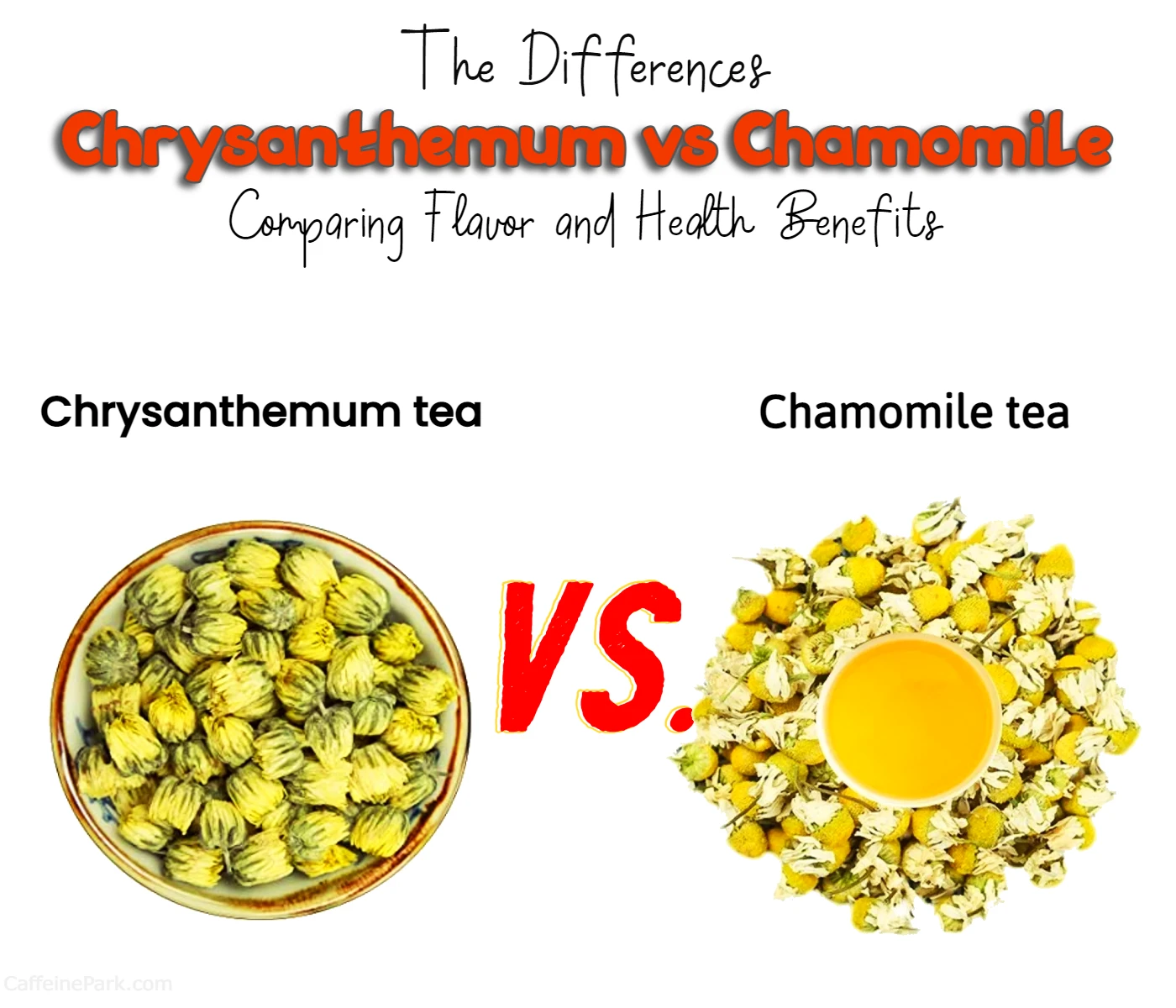Chrysanthemum tea vs Chamomile tea
Exploring the Differences Chrysanthemum and Chamomile

Are you a tea lover looking to explore different flavors and health benefits? If so, you may have heard of chrysanthemum tea and chamomile tea. While these two teas share similarities, such as their light and floral flavors, they come from different plants and offer unique benefits.
Chrysanthemum tea is a caffeine-free tea that has been popular in Asia, particularly China, for centuries. This tea is made from dried chrysanthemum flowers and is known for its ability to improve eye health and respiratory issues. It has a light and slightly sweet flavor that makes it a perfect beverage for a relaxing afternoon.
On the other hand, chamomile tea is a popular herbal tea that has been enjoyed in many countries, including the United States, Europe, and South America. Made from dried chamomile flowers, this tea has a light and floral taste with a slightly earthy undertone. Chamomile tea is known for its ability to aid digestion and promote skin health. Whether you are dealing with digestive discomfort or simply looking to enhance your skin’s natural glow, chamomile tea may be the perfect addition to your routine.
Here’s a quick table summarizing the differences between Chrysanthemum tea and Chamomile tea:
| Chrysanthemum Tea | Chamomile Tea | |
|---|---|---|
| Flavor Profile | Mildly floral with herbal undertones | Gentle, floral with a hint of apple-like sweetness |
| Aroma | Delicate and soothing, reminiscent of fresh flowers | Delicate and herbaceous, calming scent |
| Health Benefits | Relaxation, eye health, respiratory support, skin health | Sleep aid, digestive support, stress relief, anti-inflammatory properties |
| Origins | Primarily consumed in Chinese culture | Cultivated in various cultures, including Egypt, Greece, and Rome |
| Availability | Widely available in Asian grocery stores and specialty tea shops | Widely available in grocery stores, health food stores, and online retailers |
| Additional Uses | Used in traditional Chinese medicine and culinary preparations | Consult with a healthcare professional |
| Allergies | Possible allergies to Chrysanthemum flowers | Possible allergies to Chamomile flowers |
| Pregnancy and Breastfeeding | Consult with a healthcare professional | Used in skin care products and hair rinses |
| Consult with a healthcare professional | Consult with a healthcare professional | The delicate and herbaceous, calming scent |
Differences Between Chrysanthemum and Chamomile
Chrysanthemum Tea: A Floral Infusion
Chrysanthemum tea, as the name suggests, is made from the delicate flowers of the Chrysanthemum plant. This aromatic infusion has been enjoyed for centuries in various cultures for its refreshing taste and potential health benefits. Let’s dive deeper into the world of Chrysanthemum tea!
Flavor Profile and Aroma
Chrysanthemum tea offers a pleasant and mildly floral taste that is often described as slightly sweet with subtle herbal undertones. The aroma is delicate and soothing, reminiscent of fresh flowers. The flavor and fragrance of this tea can vary depending on the specific type of Chrysanthemum flowers used and the brewing method employed.
Health Benefits
Chrysanthemum tea is not only a delight for the senses but also offers several potential health benefits. Traditionally, it has been used in traditional Chinese medicine for its cooling properties. Here are a few potential benefits associated with Chrysanthemum tea:
- Relaxation and Stress Relief: Chrysanthemum tea is often consumed for its calming effects, helping to promote relaxation and alleviate stress.
- Eye Health: It is believed that Chrysanthemum tea may help support eye health due to its natural antioxidants and flavonoids, which can help protect the eyes from oxidative stress.
- Respiratory Support: Some studies suggest that Chrysanthemum tea may have expectorant properties, potentially helping to relieve symptoms of coughs and colds.
- Skin Health: Chrysanthemum tea is also known for its potential benefits to the skin, as it contains vitamins and minerals that may promote a healthy complexion.
Brewing and Serving
Brewing Chrysanthemum tea is a simple and enjoyable process. Here’s a step-by-step guide to help you prepare a delightful cup:
- Ingredients: You’ll need dried Chrysanthemum flowers and hot water.
- Water Temperature: Heat the water to around 90-95°C (194-203°F). Avoid boiling water, as it may result in a bitter taste.
- Steeping Time: Add the Chrysanthemum flowers to a teapot or cup, and pour the hot water over them. Allow the flowers to steep for 3-5 minutes to extract the flavors and aroma fully.
- Optional Additions: Chrysanthemum tea can be enjoyed as is, or you may add a touch of honey or rock sugar to enhance the sweetness if desired.
- Serving: Once steeped, strain the tea into a teacup, sit back, and savor the delicate flavors of Chrysanthemum tea.
Now that we’ve explored Chrysanthemum tea, let’s turn our attention to Chamomile tea, another beloved herbal infusion.
Chamomile Tea: Nature’s Calming Elixir
Chamomile tea is a popular herbal tea known for its soothing properties and delightful taste. This ancient brew has been cherished for its calming effects and is often consumed in the evening to promote relaxation and restful sleep. Let’s discover more about the world of Chamomile tea!
Flavor Profile and Aroma
Chamomile tea offers a gentle, floral flavor with a hint of apple-like sweetness. Its taste is often described as light, mellow, and slightly earthy. The aroma is delicate and herbaceous, releasing a calming scent that contributes to its overall relaxing qualities.
Health Benefits
Chamomile tea has a long history of use in traditional medicine, renowned for its potential health benefits. While scientific research is ongoing, here are a few potential advantages associated with Chamomile tea:
- Sleep Aid: Chamomile tea is often consumed before bedtime due to its calming properties, which may help promote restful sleep and alleviate insomnia symptoms.
- Digestive Support: Chamomile tea is known for its potential to soothe the digestive system. It may help relieve symptoms of indigestion, bloating, and stomach discomfort.
- Stress Relief: The act of sipping a warm cup of Chamomile tea can have a comforting effect, promoting relaxation and reducing stress and anxiety.
- Anti-Inflammatory Properties: Chamomile tea contains compounds with potential anti-inflammatory effects, which may help reduce inflammation in the body.
Brewing and Serving
Brewing Chamomile tea is a delightful ritual that can be enjoyed at any time of the day, especially during quiet moments when you want to unwind. Here’s a simple guide to brewing a perfect cup of Chamomile tea:
- Ingredients: You’ll need dried Chamomile flowers and hot water.
- Water Temperature: Heat the water to around 90-95°C (194-203°F). Avoid using boiling water, as it may result in a bitter taste.
- Steeping Time: Place the Chamomile flowers in a teapot or cup, and pour the hot water over them. Allow the flowers to steep for about 5-7 minutes, allowing the flavors and aroma to infuse fully.
- Optional Additions: Chamomile tea can be enjoyed on its own, or you may add a touch of honey or lemon for a hint of sweetness or tanginess, if desired.
- Serving: Once steeped, strain the tea into your favorite teacup, take a moment to appreciate its gentle aroma, and enjoy the soothing flavors of Chamomile tea.
Now that we’ve explored the unique characteristics of both Chrysanthemum tea and Chamomile tea, let’s summarize the key differences between these two delightful brews.
The Differences at a Glance
To provide a comprehensive comparison, let’s take a look at the key differences between Chrysanthemum tea and Chamomile tea in a table format:
| Chrysanthemum Tea | Chamomile Tea | |
|---|---|---|
| Flavor Profile | Mildly floral, slightly sweet with herbal undertones | Gentle, floral, with a hint of apple-like sweetness |
| Aroma | Delicate and soothing, reminiscent of fresh flowers | Delicate and herbaceous, calming scent |
| Health Benefits | Relaxation, eye health, respiratory support, skin health | Sleep aid, digestive support, stress relief, anti-inflammatory properties |
| Brewing Temperature | 90-95°C (194-203°F) | 90-95°C (194-203°F) |
| Steeping Time | 3-5 minutes | 5-7 minutes |
Origins and Cultural Significance
Chrysanthemum tea holds a special place in Chinese culture and has been consumed for centuries. In China, Chrysanthemum flowers are highly revered and symbolize longevity, purity, and good health. The tea is often enjoyed during special occasions and festivals, as well as for its potential medicinal properties.
Chamomile tea, on the other hand, has a rich history that spans different cultures. It has been used for centuries in traditional medicine practices in Egypt, Greece, and Rome. The word “Chamomile” is derived from the Greek words “chamos” (ground) and “mēlon” (apple), referring to its earthy aroma and apple-like flavor.
Varieties and Availability
Both Chrysanthemum tea and Chamomile tea come in various varieties and are widely available in different forms.
Chrysanthemum tea can be made from different species of Chrysanthemum flowers, including the white-flowered Chrysanthemum indicum and the yellow-flowered Chrysanthemum morifolium. These flowers are typically dried and used to make the tea. Chrysanthemum tea is commonly found in loose-leaf form or pre-packaged tea bags in Asian grocery stores or specialty tea shops.
Chamomile tea is primarily made from two main species: German Chamomile (Matricaria chamomilla) and Roman Chamomile (Chamaemelum nobile). The flowers are dried and used to brew the tea. Chamomile tea is widely available in both loose-leaf and tea bag forms and can be found in most grocery stores, health food stores, and online retailers.
Additional Uses and Applications
While Chrysanthemum tea and Chamomile tea are popularly consumed as soothing beverages, they also have other applications:
- Chrysanthemum tea is sometimes used as an ingredient in traditional Chinese herbal remedies, where it is believed to have cooling and detoxifying properties. It is also used in culinary preparations, such as in soups, stews, and desserts.
- Chamomile tea is not only enjoyed as a beverage but is also used in skincare products, such as facial cleansers, creams, and lotions, due to its potential benefits for the skin. It can also be used as a rinse for hair to enhance shine and promote a healthy scalp.
Precautions and Considerations
While Chrysanthemum tea and Chamomile tea are generally safe to consume, it’s important to be aware of a few considerations:
- Allergies: Some individuals may be allergic to Chrysanthemum or Chamomile flowers. If you have known allergies to plants in the Asteraceae family (which includes ragweed, daisies, and marigolds), it’s advisable to exercise caution or consult with a healthcare professional before consuming these teas.
- Pregnancy and breastfeeding: Pregnant or breastfeeding women should exercise caution when consuming herbal teas, including Chrysanthemum tea and Chamomile tea. It’s best to consult with a healthcare professional for personalized advice.
- Medication interactions: Herbal teas can interact with certain medications. If you are taking any medications, it’s recommended to consult with your healthcare provider to ensure there are no potential interactions between the tea and your medications.
Which Tea Is Right for You? Chamomile or Chrysanthemum
Choosing between Chamomile tea and Chrysanthemum tea depends on your personal preferences and the specific benefits you are seeking. Let’s summarize the key factors to consider when deciding which tea is right for you:
Choose Chamomile Tea if:
- You are looking for a tea that promotes relaxation and aids in sleep.
- You enjoy a gentle, floral flavor with a hint of apple-like sweetness.
- You want a tea that may support digestive health and soothe stomach discomfort.
- You prefer a widely available tea that can be found in most grocery stores and online retailers.
- You are interested in the potential anti-inflammatory properties of Chamomile tea.
Choose Chrysanthemum Tea if:
- You prefer a mildly floral flavor with subtle herbal undertones.
- You are looking for a tea that may help promote relaxation and alleviate stress.
- You are interested in potential eye health benefits and support for respiratory health.
- You want to explore a tea with cultural significance in Chinese traditions.
- You are open to trying a tea with potential benefits for skin health.
It’s important to note that both teas offer potential health benefits and can be enjoyed for their calming properties. Ultimately, the choice between Chamomile tea and Chrysanthemum tea is a personal one. You may even choose to incorporate both teas into your routine and alternate based on your mood and desired effects. Remember to consider any allergies, pregnancy or breastfeeding concerns, and potential interactions with medications before incorporating any herbal teas into your lifestyle.
Alternative to chrysanthemum and chamomile
If you’re looking for alternatives to chrysanthemum tea and chamomile tea, there are several other teas that offer unique flavors and health benefits. Here are a few options to consider:
- Green tea: Green tea is a popular tea that’s known for its high antioxidant content and potential health benefits. It has a light and slightly grassy flavor that can be enjoyed on its own or with added flavors like honey or lemon.
- Peppermint tea: Peppermint tea is a refreshing and invigorating tea that’s known for its ability to soothe digestive issues and promote relaxation. It has a strong minty flavor that can be enjoyed hot or cold.
- Ginger tea: Ginger tea is a spicy and warming tea that’s often used to aid digestion and soothe nausea. It has a strong and slightly pungent flavor that can be enjoyed on its own or with added flavors like lemon or honey.
- Lavender tea: Lavender tea is a fragrant and calming tea that’s known for its ability to promote relaxation and reduce stress. It has a light and floral flavor that can be enjoyed hot or cold.
No matter which tea you choose, make sure to choose high-quality, organic tea leaves to ensure the best flavor and potential health benefits.
FAQs
It’s not necessarily a matter of one tea being better than the other, as they both offer unique health benefits and flavors. Chrysanthemum tea is known for improving eye health and respiratory issues, while chamomile tea is often used to aid with digestion and promote skin health. Ultimately, the choice between chrysanthemum tea and chamomile tea depends on your personal preferences and health needs.
Yes, both chrysanthemum tea and chamomile tea are safe for consumption. However, it’s important to keep in mind that individual reactions may vary, so it’s best to consult with your healthcare provider if you have any concerns.
If you have a known allergy to chrysanthemum or chamomile, it’s best to avoid drinking these teas. Additionally, if you have a history of allergies or are unsure if you have an allergy, it’s best to consult with your healthcare provider before consuming these teas.
To prepare chrysanthemum tea, steep dried chrysanthemum flowers in hot water for several minutes, then strain and enjoy. For chamomile tea, steep dried chamomile flowers in hot water for 5-10 minutes, then strain and enjoy. Both teas can be enjoyed hot or cold.
No, both chrysanthemum tea and chamomile tea are caffeine-free, making them a great choice for those who are sensitive to caffeine or looking to cut back on their caffeine intake.
Read More:





